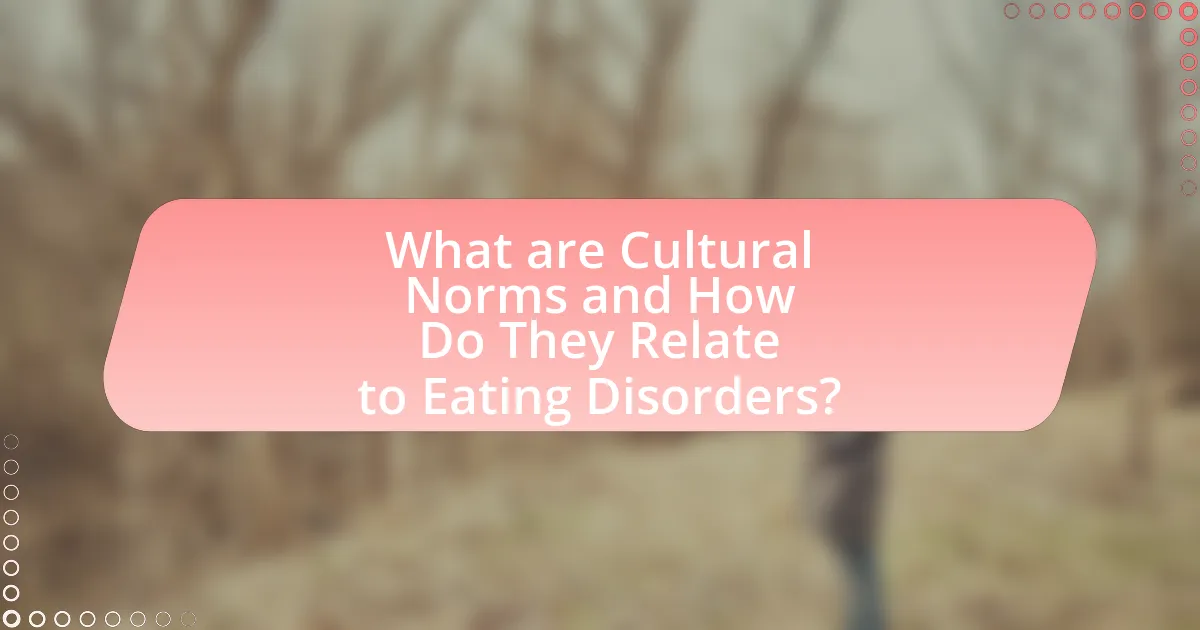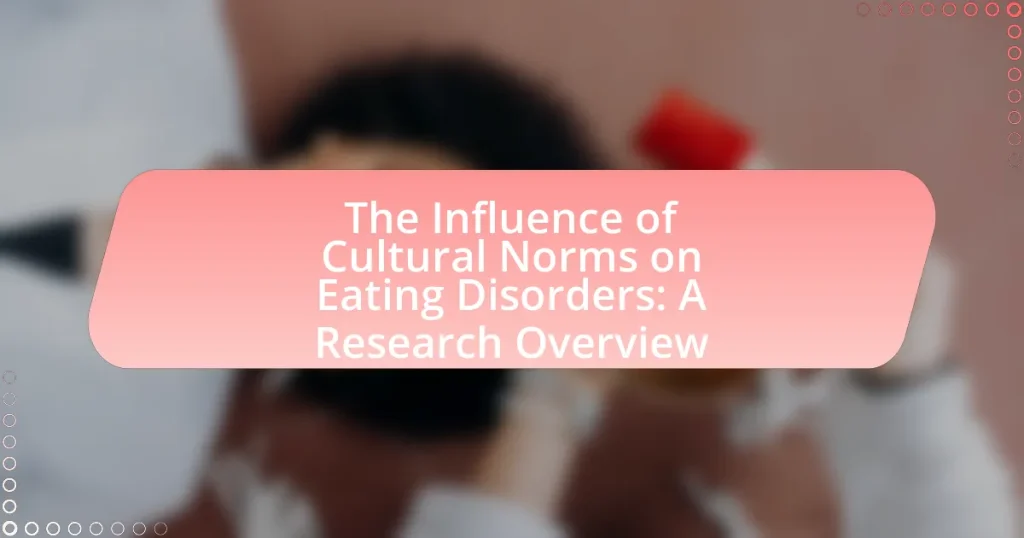The article examines the influence of cultural norms on eating disorders, highlighting how shared societal expectations shape perceptions of body image and eating behaviors. It discusses the correlation between cultural ideals, such as the glorification of thinness in Western societies, and the prevalence of disorders like anorexia and bulimia. The article also explores the role of media representations, cultural identity, and family dynamics in shaping attitudes towards food and body image, as well as the implications for prevention and treatment strategies. Additionally, it emphasizes the importance of culturally sensitive approaches in addressing eating disorders and improving recovery outcomes.

What are Cultural Norms and How Do They Relate to Eating Disorders?
Cultural norms are the shared expectations and rules that guide behavior within a society, influencing individuals’ perceptions of acceptable practices, including those related to body image and eating habits. These norms can significantly contribute to the development of eating disorders, as societal ideals often promote unrealistic body standards, leading individuals to engage in harmful behaviors to conform. For instance, research indicates that cultures emphasizing thinness as an ideal correlate with higher rates of anorexia and bulimia, particularly among women. A study published in the “International Journal of Eating Disorders” by Stice and Shaw (2002) found that exposure to media portraying thin ideals increased body dissatisfaction and disordered eating behaviors among young women. Thus, cultural norms play a crucial role in shaping attitudes toward food and body image, directly impacting the prevalence of eating disorders.
How do cultural norms shape perceptions of body image?
Cultural norms significantly shape perceptions of body image by establishing standards of beauty and desirability that individuals internalize. These norms vary across different societies and can dictate what is considered attractive, leading to pressure to conform to specific body ideals. For instance, in Western cultures, thinness is often idealized, which has been linked to increased rates of eating disorders, as evidenced by research from the National Eating Disorders Association, which highlights that societal pressures contribute to body dissatisfaction and unhealthy behaviors. Conversely, some cultures may celebrate larger body sizes as symbols of wealth and health, demonstrating that cultural context plays a crucial role in shaping individual perceptions of body image.
What role do media representations play in shaping these perceptions?
Media representations significantly shape perceptions of body image and eating behaviors, influencing societal norms and individual self-esteem. Research indicates that exposure to idealized body types in media correlates with increased body dissatisfaction and disordered eating behaviors among viewers. For instance, a study published in the journal “Psychological Bulletin” found that women exposed to thin-ideal images reported higher levels of body dissatisfaction and a greater likelihood of engaging in unhealthy weight control behaviors. This demonstrates that media not only reflects cultural norms but actively contributes to the internalization of unrealistic standards, thereby impacting mental health and eating disorder prevalence.
How do cultural standards of beauty differ across societies?
Cultural standards of beauty vary significantly across societies, influenced by historical, social, and economic factors. For instance, in Western cultures, thinness is often idealized, as evidenced by the prevalence of size-zero models in fashion, while in some African cultures, a fuller body is associated with wealth and fertility, reflecting different societal values. Research by Swami et al. (2010) in “Body Image” highlights that these differing ideals can lead to varying rates of body dissatisfaction and eating disorders, with Western societies experiencing higher incidences of anorexia and bulimia compared to cultures that celebrate larger body types.
Why are eating disorders prevalent in certain cultures?
Eating disorders are prevalent in certain cultures due to the strong influence of cultural norms that prioritize thinness and specific body ideals. In societies where media representation glorifies slim figures, individuals may feel pressured to conform to these standards, leading to unhealthy eating behaviors. Research indicates that cultures with high levels of media exposure, such as Western societies, report higher rates of eating disorders, with studies showing that 20% of women in the U.S. experience disordered eating behaviors linked to societal pressures. Additionally, cultural practices and values surrounding food, body image, and femininity can exacerbate these issues, as seen in cultures that emphasize appearance as a measure of success.
What cultural factors contribute to the development of eating disorders?
Cultural factors significantly contribute to the development of eating disorders by promoting unrealistic body ideals and stigmatizing certain body types. Societal pressures, particularly in Western cultures, emphasize thinness as a standard of beauty, leading individuals to engage in harmful dieting behaviors. Research indicates that media portrayals of idealized body images can trigger body dissatisfaction, particularly among young women, which is a known risk factor for eating disorders. For instance, a study published in the “International Journal of Eating Disorders” by Tiggemann and Slater (2014) found that exposure to thin-ideal media was linked to increased body dissatisfaction and disordered eating behaviors in adolescents. Additionally, cultural norms surrounding food, such as the glorification of dieting and the demonization of certain foods, further exacerbate these issues, creating an environment where eating disorders can thrive.
How do societal pressures influence individual behavior regarding food?
Societal pressures significantly influence individual behavior regarding food by shaping perceptions of body image, dietary choices, and eating habits. These pressures often stem from cultural norms, media representations, and social expectations that dictate what is considered desirable or acceptable in terms of appearance and food consumption. For instance, research indicates that exposure to idealized body images in media can lead to increased body dissatisfaction and unhealthy eating behaviors, particularly among adolescents (Tiggemann & Slater, 2014, International Journal of Eating Disorders). Additionally, societal norms around dieting and food restriction can pressure individuals to conform, leading to disordered eating patterns. This correlation between societal expectations and individual behavior highlights the profound impact of cultural influences on food-related decisions.
What is the relationship between cultural identity and eating disorders?
Cultural identity significantly influences the prevalence and manifestation of eating disorders. Individuals from cultures that emphasize thinness and specific body ideals are more likely to develop disorders such as anorexia and bulimia. Research indicates that cultural pressures, including media representation and societal expectations, contribute to body dissatisfaction and unhealthy eating behaviors. For instance, a study published in the “International Journal of Eating Disorders” by Becker et al. (2002) found that Fijian girls experienced increased eating disorder symptoms after the introduction of Western media, highlighting the direct impact of cultural identity on eating behaviors.
How does cultural identity impact eating habits and attitudes towards food?
Cultural identity significantly impacts eating habits and attitudes towards food by shaping preferences, practices, and perceptions related to food consumption. For instance, individuals from collectivist cultures may prioritize communal meals and traditional recipes, which fosters a sense of belonging and identity. Research indicates that cultural norms dictate dietary restrictions, such as vegetarianism in Hindu culture or halal practices in Islam, influencing food choices and attitudes towards certain foods. Additionally, studies show that cultural identity can affect body image and perceptions of health, as seen in the research by Puhl and Heuer (2010), which highlights how cultural standards of beauty can lead to disordered eating behaviors. Thus, cultural identity plays a crucial role in determining not only what people eat but also how they view food and their bodies.
What are the implications of cultural dislocation on eating disorders?
Cultural dislocation significantly increases the risk of developing eating disorders. This phenomenon occurs when individuals experience a disconnect from their cultural identity, often due to migration or globalization, leading to feelings of alienation and stress. Research indicates that individuals facing cultural dislocation may adopt the eating behaviors and ideals of the dominant culture, which can contribute to body dissatisfaction and unhealthy eating patterns. For instance, a study published in the “International Journal of Eating Disorders” found that immigrant populations often experience higher rates of anorexia and bulimia as they navigate conflicting cultural standards regarding body image and food. This evidence underscores the direct link between cultural dislocation and the prevalence of eating disorders.

How Do Different Cultures Approach Eating Disorders?
Different cultures approach eating disorders through varying lenses of societal norms, values, and beliefs. For instance, Western cultures often emphasize thinness as an ideal, leading to higher rates of disorders like anorexia and bulimia, as evidenced by studies showing that 0.5% to 1% of women in the U.S. experience anorexia at some point in their lives. In contrast, some non-Western cultures may prioritize body size differently; for example, in certain African cultures, larger body sizes are often associated with wealth and health, which can lead to lower prevalence rates of eating disorders. Research published in the “International Journal of Eating Disorders” highlights that cultural perceptions of beauty and health significantly influence the manifestation and prevalence of eating disorders across different societies.
What are the varying definitions of eating disorders across cultures?
Eating disorders are defined differently across cultures, reflecting varying societal norms, values, and perceptions of body image. In Western cultures, eating disorders such as anorexia nervosa and bulimia nervosa are often characterized by an obsession with thinness and weight control, influenced by media portrayals of ideal body types. Conversely, in some non-Western cultures, such as certain African and Asian societies, the emphasis may be on body size as a symbol of wealth and health, leading to different manifestations of disordered eating, such as binge eating or overeating. Research indicates that cultural context significantly shapes the understanding and prevalence of eating disorders, as seen in studies like “Cultural Variations in Eating Disorders” by K. M. Becker et al., which highlights how cultural attitudes towards food and body image can lead to distinct definitions and experiences of eating disorders across different populations.
How do cultural beliefs influence the understanding of eating disorders?
Cultural beliefs significantly shape the understanding of eating disorders by framing societal norms around body image, food consumption, and health. For instance, in cultures that prioritize thinness as an ideal, individuals may develop a heightened risk for disorders such as anorexia nervosa, as evidenced by research indicating that Western societies often associate thinness with success and desirability (Stice, 2002). Conversely, cultures that celebrate larger body sizes may view them as symbols of wealth and health, which can lead to different manifestations of eating disorders, such as binge eating disorder. This cultural context influences not only the prevalence of specific disorders but also the stigma and treatment approaches associated with them, as highlighted in studies that show varying perceptions of eating disorders across different cultural groups (Murray et al., 2010).
What are the cultural stigmas associated with eating disorders?
Cultural stigmas associated with eating disorders include perceptions of weakness, lack of willpower, and moral failing. These stigmas often lead to shame and isolation for individuals suffering from these disorders, as society tends to view them as personal choices rather than serious mental health issues. Research indicates that in many cultures, particularly those emphasizing thinness and beauty, individuals with eating disorders face discrimination and judgment, which can exacerbate their conditions. For instance, a study published in the “International Journal of Eating Disorders” highlights that societal pressures and unrealistic body standards contribute significantly to the stigma surrounding eating disorders, making it difficult for affected individuals to seek help.
How do treatment approaches differ by culture?
Treatment approaches for eating disorders differ significantly by culture due to varying beliefs, values, and practices surrounding health and body image. For instance, in Western cultures, treatment often emphasizes individual therapy and medical interventions, focusing on psychological aspects and personal responsibility. In contrast, many non-Western cultures may prioritize family involvement and community support, viewing eating disorders as a collective issue rather than an individual one. Research indicates that cultural perceptions of body image and health can influence treatment efficacy; for example, a study published in the “International Journal of Eating Disorders” by K. M. Becker et al. found that culturally adapted interventions led to better outcomes in diverse populations. This highlights the importance of tailoring treatment approaches to align with cultural norms and values for effective management of eating disorders.
What traditional practices are used in different cultures to address eating disorders?
Traditional practices used in different cultures to address eating disorders include community-based healing rituals, dietary modifications, and holistic approaches. For instance, in some Indigenous cultures, communal meals and storytelling are employed to foster a sense of belonging and emotional support, which can alleviate symptoms of eating disorders. In Japan, traditional practices such as Shinrin-yoku, or forest bathing, promote mental well-being and can help individuals reconnect with their bodies and food in a positive manner. Additionally, Ayurvedic medicine in India emphasizes balanced diets and lifestyle changes tailored to individual needs, which can aid in recovery from eating disorders. These practices are rooted in cultural beliefs that prioritize community, mental health, and holistic well-being, demonstrating their effectiveness in addressing eating disorders across various societies.
How effective are culturally adapted treatments for eating disorders?
Culturally adapted treatments for eating disorders are highly effective, as they address the specific cultural contexts and values that influence individuals’ relationships with food and body image. Research indicates that these treatments can lead to significant improvements in symptoms and overall well-being. For instance, a meta-analysis published in the journal “Cultural Diversity and Ethnic Minority Psychology” found that culturally tailored interventions resulted in better treatment outcomes compared to standard approaches, particularly among minority populations. This effectiveness is attributed to the incorporation of culturally relevant practices, beliefs, and social support systems, which enhance engagement and adherence to treatment.
What role do family dynamics play in different cultural contexts?
Family dynamics significantly influence individual behaviors and mental health outcomes across various cultural contexts. In collectivist cultures, such as many Asian societies, family cohesion and expectations can lead to heightened pressure to conform to specific body ideals, which may contribute to the development of eating disorders. Conversely, in individualistic cultures, like those in Western societies, family dynamics may emphasize personal autonomy, potentially resulting in different manifestations of eating disorders, such as a focus on personal achievement and self-image. Research indicates that familial relationships, including communication patterns and support systems, play a crucial role in shaping these cultural influences on eating disorders, highlighting the need for culturally sensitive approaches in treatment and prevention strategies.
How do family expectations influence eating behaviors in various cultures?
Family expectations significantly shape eating behaviors across various cultures by dictating norms around food consumption, meal practices, and body image. In collectivist cultures, such as those in Asia and Latin America, family meals are often central to social cohesion, leading individuals to prioritize communal eating over personal preferences, which can result in overeating or adherence to traditional diets. Conversely, in individualistic cultures like the United States, family expectations may emphasize personal choice and body image, potentially leading to restrictive eating behaviors or dieting practices influenced by societal standards. Research indicates that these cultural frameworks can contribute to the development of eating disorders, as individuals navigate the pressures of familial and societal expectations regarding food and body image. For instance, a study published in the “International Journal of Eating Disorders” by K. M. Becker et al. highlights how familial pressure in Western cultures can exacerbate disordered eating patterns among adolescents.
What is the impact of familial support on recovery from eating disorders?
Familial support significantly enhances recovery from eating disorders. Research indicates that individuals with strong family support systems experience better treatment outcomes, including reduced symptoms and improved psychological well-being. A study published in the Journal of Eating Disorders found that patients who reported higher levels of family involvement in their treatment had a 50% greater chance of achieving full recovery compared to those with minimal family engagement. This underscores the critical role that a supportive family environment plays in the healing process for those struggling with eating disorders.

What Are the Implications of Cultural Norms on Prevention and Treatment?
Cultural norms significantly influence the prevention and treatment of eating disorders by shaping individuals’ perceptions of body image, health, and acceptable behaviors. For instance, cultures that prioritize thinness may lead to higher rates of disordered eating behaviors, as individuals strive to conform to these ideals. Research indicates that in Western societies, where thinness is often equated with success and attractiveness, individuals are more likely to develop eating disorders compared to those in cultures with diverse body ideals. Furthermore, treatment approaches can be affected by cultural beliefs; for example, some cultures may stigmatize mental health issues, making individuals less likely to seek help. A study published in the “International Journal of Eating Disorders” by K. M. Becker et al. (2010) highlights that culturally tailored interventions are more effective in addressing eating disorders, as they resonate better with the values and beliefs of the affected individuals. Thus, understanding cultural norms is essential for developing effective prevention strategies and treatment plans for eating disorders.
How can understanding cultural norms improve prevention strategies?
Understanding cultural norms can significantly enhance prevention strategies by tailoring interventions to align with the values and beliefs of specific communities. When prevention strategies are culturally relevant, they are more likely to resonate with individuals, leading to increased engagement and effectiveness. For instance, research indicates that culturally adapted programs, which consider local customs and social dynamics, have shown higher success rates in reducing eating disorders among diverse populations. A study published in the “International Journal of Eating Disorders” by researchers like Becker et al. (2010) demonstrated that culturally sensitive approaches led to improved outcomes in treatment adherence and reduced stigma, ultimately fostering a supportive environment for individuals at risk.
What community-based initiatives have been effective in addressing eating disorders?
Community-based initiatives that have been effective in addressing eating disorders include peer support groups, educational programs, and community awareness campaigns. Peer support groups provide individuals with a safe space to share experiences and receive encouragement, which has been shown to improve recovery outcomes. Educational programs in schools and community centers raise awareness about the risks of eating disorders and promote healthy body image, leading to a decrease in the prevalence of these disorders. Additionally, community awareness campaigns, such as those led by organizations like the National Eating Disorders Association, have successfully engaged the public in discussions about eating disorders, reducing stigma and encouraging individuals to seek help. These initiatives collectively contribute to a supportive environment that fosters recovery and prevention.
How can education programs be tailored to different cultural contexts?
Education programs can be tailored to different cultural contexts by incorporating culturally relevant content, teaching methods, and community involvement. For instance, integrating local dietary practices and beliefs into the curriculum can enhance relatability and engagement. Research shows that culturally adapted interventions, such as those that consider specific cultural attitudes towards body image and food, are more effective in addressing issues like eating disorders. A study published in the Journal of Eating Disorders found that culturally sensitive approaches significantly improved treatment outcomes among diverse populations, highlighting the importance of aligning educational content with cultural values and norms.
What best practices exist for culturally sensitive treatment of eating disorders?
Culturally sensitive treatment of eating disorders involves integrating cultural understanding into therapeutic practices. Best practices include conducting thorough cultural assessments to understand the patient’s background, beliefs, and values, which can influence their relationship with food and body image. Additionally, employing culturally relevant therapeutic modalities, such as incorporating traditional healing practices or community support systems, enhances engagement and effectiveness. Training healthcare providers in cultural competence is essential, as it fosters empathy and reduces biases in treatment. Research indicates that culturally adapted interventions can lead to better outcomes, as they resonate more with patients’ lived experiences and cultural contexts. For instance, a study published in the “International Journal of Eating Disorders” highlights that culturally tailored approaches significantly improve treatment adherence and satisfaction among diverse populations.
How can healthcare providers incorporate cultural competence in treatment?
Healthcare providers can incorporate cultural competence in treatment by actively engaging in training that enhances their understanding of diverse cultural backgrounds and their impact on health behaviors. This training should include education on cultural beliefs, values, and practices related to health and illness, which can significantly influence patient interactions and treatment adherence. Research indicates that culturally competent care improves patient satisfaction and outcomes; for instance, a study published in the Journal of Health Care for the Poor and Underserved found that culturally tailored interventions led to better health outcomes among minority populations. By integrating cultural competence into their practice, healthcare providers can foster trust, improve communication, and ultimately enhance the effectiveness of treatment for eating disorders influenced by cultural norms.
What resources are available for culturally specific support groups?
Culturally specific support groups are available through various organizations that focus on the unique needs of different communities. For instance, the National Asian American Pacific Islander Mental Health Association provides culturally relevant resources and support for Asian American and Pacific Islander individuals. Additionally, the National Alliance on Mental Illness offers resources tailored to various cultural backgrounds, including specific programs for Hispanic and Latino communities. Research indicates that culturally tailored interventions can significantly improve engagement and outcomes in mental health support, highlighting the importance of these resources in addressing eating disorders influenced by cultural norms.
What practical steps can individuals take to combat the influence of harmful cultural norms?
Individuals can combat the influence of harmful cultural norms by actively promoting body positivity and diversity in media representations. Engaging in discussions that challenge stereotypes and advocating for inclusive portrayals can help reshape societal perceptions. Research indicates that exposure to diverse body types in media reduces the prevalence of eating disorders, as shown in a study published in the Journal of Eating Disorders, which found that individuals who viewed body-positive content reported improved body image and self-esteem. Additionally, individuals can support organizations that focus on mental health and body image advocacy, further amplifying efforts to counteract negative cultural influences.


